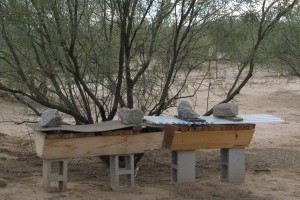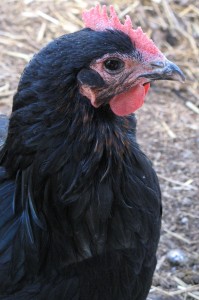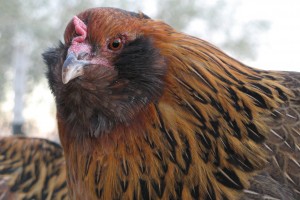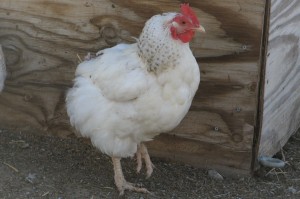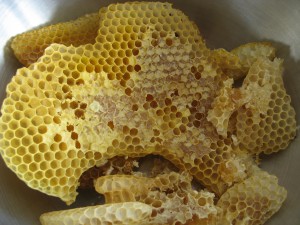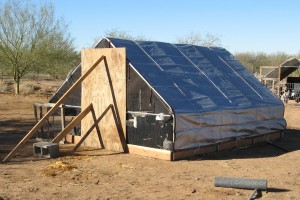My sixth farm was ReZoNation near Marana, Arizona.
The Farm
The farmers are Jaime and Kara. Jaime grew up around gardens and his father’s beehives. After going away to college and working as an engineer, he returned to the land. Jaime’s father bought fifty acres of former pastureland in 1998. In 2005, Jaime acquired half of it. The land is flat, arid and used up from the decades of farming. Jaime spent two years observing his new land before deciding on a plan to start his farm. Ways to deal with the extreme heat, high winds, and small amounts of rainfall needed to be figured out. Jaime dug sunken garden beds to help keep the soil from blowing away and keep the moisture from evaporating, built swales to keep the water in one spot, and planted mesquite trees for cooling shade and to create wind breaks. “Farming here would be impossible without them,” Jaime remarked referring to the trees. Six years into farming, ReZoNation has around 250 chickens, 80 plus beehives, two rescue sheep and two rescue goats. Piglets come and go. The farm’s main products are honey, pork and eggs.
My Farm Experience
My day started at 8:00 am when I left the house to tend to the chickens. There are six main breeds of chickens on the farm: Goth-like French Copper Maran, grey and white Barred Rock, orangey-red Rhode Island Red, lacy white Wyandotte, Araucana, or Easter Egg, of many colors, and stark white Delaware. It took me a while to know who was who. Three of the five flocks have mobile chicken tractors inside an electric fence that gives them lots of space to peck around. The first thing I did in the morning was to let the chickens out of the tractors where they spend the night safely roosting. I got a kick out of opening the door for the Barred Rocks and watching them jump up on the low wooden frame at the door of the coop in groups of two or three and jump out of the coop and run to their feeder. I thought it would make a cute YouTube video. Once all the chickens were let out for the day, I counted out scoops of chicken feed from fifty pound bags and carried the bucket over to the chicken coops. The chickens were hungry and clustered in front of me. Bold ones would try to jump onto the bucket. Once I dropped a scoop of food into one of their metal pans, the chickens formed a circle around it and a frenzy of ‘tap, tap, tap’ began as they tapped their beaks into the pan to get the grain. Frequently there was a opportunistic rude chicken who would walk over the backs of the feeding chickens to stand in the middle of the pan surrounded by the grain the other chickens couldn’t reach. Some of the flocks were excited to see me until they realized I wasn’t the one with the spent grain. Spent grain, also called brewer’s grain or wort, is the leftover barley and hops from 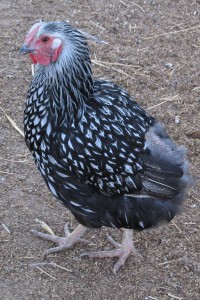 the beer brewing process. Breweries throw it away, but it makes good feed for birds and goats. Small farmers seek it out since it is free and a way to cut the high cost of feeding their animals. Jaime told me that they wouldn’t make any money off their eggs if they didn’t have the spent grain. The chickens love the sweetness of the spent grain and fall all over themselves when it arrived in a wheelbarrow. My favorite flock to feed was the young Barred Rock chicks. They were a few months old and looked more like grey and white bananas with chicken legs than full-sized chickens. They were still at that curious age so they would peck at my boots, jump on my back, stand in a half circle and stare up at me with their head cocked to one side, and generally cause mischief. They had outgrown their small coop and were so tightly packed that it was easy to reach down and pick one up since they couldn’t easily run away. My favorite to pick up was a chick that was half the size of the others. While she didn’t resist when I picked her up, once I was holding her, she clucked and pecked at my arm. I named her Little Pecker. As soon as all the chickens, two sheep and two goats were fed, it was time for breakfast.
the beer brewing process. Breweries throw it away, but it makes good feed for birds and goats. Small farmers seek it out since it is free and a way to cut the high cost of feeding their animals. Jaime told me that they wouldn’t make any money off their eggs if they didn’t have the spent grain. The chickens love the sweetness of the spent grain and fall all over themselves when it arrived in a wheelbarrow. My favorite flock to feed was the young Barred Rock chicks. They were a few months old and looked more like grey and white bananas with chicken legs than full-sized chickens. They were still at that curious age so they would peck at my boots, jump on my back, stand in a half circle and stare up at me with their head cocked to one side, and generally cause mischief. They had outgrown their small coop and were so tightly packed that it was easy to reach down and pick one up since they couldn’t easily run away. My favorite to pick up was a chick that was half the size of the others. While she didn’t resist when I picked her up, once I was holding her, she clucked and pecked at my arm. I named her Little Pecker. As soon as all the chickens, two sheep and two goats were fed, it was time for breakfast.
There were two other WWOOFers on the farm for the first two weeks I was there. They liked to make oatmeal. I learned on my first farm back in July that oatmeal could actually be edible if peanut butter and jam were added to it. Jaime brewed mate tea with freshly cut lemongrass in a coffee pot. Honey from the farm was put into everything. It was a sweet breakfast.
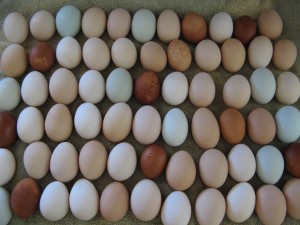 After breakfast it was time for my favorite activity: collecting eggs. Egg production started around 10:00 and there were quite a few eggs to collect by 11:00. The French Copper Maran hens laid dark brown eggs. The Easter Eggs laid some blue or olive eggs. All the others laid white or very light brown eggs. If there was a hen in the nest box, I gently put my hand under her and felt around for eggs. Frequently there would be five or six eggs under her. Hens like to collect a clutch of eggs as if they were going to incubate them so the hens will lay their eggs in the same nest box. When hens are in the mood to incubate a clutch of eggs, they become broody and stay sitting in a nest box. There was one broody French Copper Maran. She squawked like she was on fire when I walked in to collect eggs. Her beak went after my hands when I moved towards her. I let her be for a few days, then decided I liked the challenge of checking under her for eggs. There never were any. My main hazard collecting eggs wasn’t the pecking beaks but the electric fences. Two of the fences I climbed over using cinder block steps, the third one I had to lower the flexible fence and step over it. My clunky rubber boots would miss going over the top wire and instead go into one of the square holes of the lattice fence. There was no getting my foot back out while standing up once it was in there. I got tangled up and tumbled off the stairs a few times and fell backwards with a bucket of eggs after getting my foot caught in the fence I was supposed to step over. Cracking the eggs meant there were more to keep for our use since they couldn’t be sold.
After breakfast it was time for my favorite activity: collecting eggs. Egg production started around 10:00 and there were quite a few eggs to collect by 11:00. The French Copper Maran hens laid dark brown eggs. The Easter Eggs laid some blue or olive eggs. All the others laid white or very light brown eggs. If there was a hen in the nest box, I gently put my hand under her and felt around for eggs. Frequently there would be five or six eggs under her. Hens like to collect a clutch of eggs as if they were going to incubate them so the hens will lay their eggs in the same nest box. When hens are in the mood to incubate a clutch of eggs, they become broody and stay sitting in a nest box. There was one broody French Copper Maran. She squawked like she was on fire when I walked in to collect eggs. Her beak went after my hands when I moved towards her. I let her be for a few days, then decided I liked the challenge of checking under her for eggs. There never were any. My main hazard collecting eggs wasn’t the pecking beaks but the electric fences. Two of the fences I climbed over using cinder block steps, the third one I had to lower the flexible fence and step over it. My clunky rubber boots would miss going over the top wire and instead go into one of the square holes of the lattice fence. There was no getting my foot back out while standing up once it was in there. I got tangled up and tumbled off the stairs a few times and fell backwards with a bucket of eggs after getting my foot caught in the fence I was supposed to step over. Cracking the eggs meant there were more to keep for our use since they couldn’t be sold.
In the afternoons, I worked on various projects. A couple times a week I washed and packaged the eggs to take to the Tucson co-op on Fridays. The chicks needed a bigger home. Jaime designed a chicken tractor that was large and lightweight enough that it could easily be moved by two people. It was made out of PCV pipe instead of heavy wood. I wanted to see the chicks in their new home before I left the farm so I eagerly wanted to work on it. Once the frame was up, the other big part that needed to be done was putting chicken wire around the bottom half. That was my job. I put a piece of wire around the frame and through the chicken wire and then used pliers to twist it tight on the frame. It wasn’t 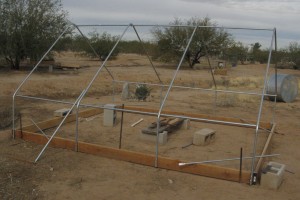 easy to get it right. The wire frequently was too loose around the frame. When I tried tightening it, the wire would break off in the pliers. The bottom of the chicken wire was attached to the wood frame with staple-like nails that had two legs of slightly different lengths. When I first started nailing them, one leg would splay and end up outside the wood. I flattened a lot of the nails. But I persevered. I tried hammering them at different angles, holding them with my fingers for a longer time, putting the long leg on the bottom, putting the long leg on the top, hammering them hard, tapping them softly, standing up, and sitting down. Finally all the practice paid off and the nails on the last side of the coop were hammered in perfectly. There was just some final framing and a tarp for the top and the coop would be ready for the chicks. The other big project was creating an area for a new garden bed. A berm of soil curved along that piece of the property. The berm was going to have a rock wall built into it and the land around it leveled so that water wouldn’t run off or pool. On top of the berm Jaime was going to plant aloes. It would be decorative when it was finished. Jaime showed us how to use re-bar, string a level and an A-frame to measure the levelness of the land. We pounded in a re-bar where the ground was at the elevation he wanted, then we pounded in another re-bar in front of where the rock wall
easy to get it right. The wire frequently was too loose around the frame. When I tried tightening it, the wire would break off in the pliers. The bottom of the chicken wire was attached to the wood frame with staple-like nails that had two legs of slightly different lengths. When I first started nailing them, one leg would splay and end up outside the wood. I flattened a lot of the nails. But I persevered. I tried hammering them at different angles, holding them with my fingers for a longer time, putting the long leg on the bottom, putting the long leg on the top, hammering them hard, tapping them softly, standing up, and sitting down. Finally all the practice paid off and the nails on the last side of the coop were hammered in perfectly. There was just some final framing and a tarp for the top and the coop would be ready for the chicks. The other big project was creating an area for a new garden bed. A berm of soil curved along that piece of the property. The berm was going to have a rock wall built into it and the land around it leveled so that water wouldn’t run off or pool. On top of the berm Jaime was going to plant aloes. It would be decorative when it was finished. Jaime showed us how to use re-bar, string a level and an A-frame to measure the levelness of the land. We pounded in a re-bar where the ground was at the elevation he wanted, then we pounded in another re-bar in front of where the rock wall 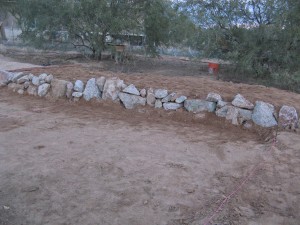 would go. We tied the string at the base of the re-bar by the rock wall area and pulled it tight to the other re-bar. We put the level on the string and moved the string up and down the re-bar until it was level. The height of the string showed how much soil needed to be removed from the rock wall end to make it level. It was a good three to four inches. We set to work digging and scraping. The first section was ready for the big rocks the following day. The rocks were set in and the berm flattened down. We were impressed how nice it looked.
would go. We tied the string at the base of the re-bar by the rock wall area and pulled it tight to the other re-bar. We put the level on the string and moved the string up and down the re-bar until it was level. The height of the string showed how much soil needed to be removed from the rock wall end to make it level. It was a good three to four inches. We set to work digging and scraping. The first section was ready for the big rocks the following day. The rocks were set in and the berm flattened down. We were impressed how nice it looked.
The warm days gave way to cold nights. The first frost of the season was coming and we had to prepare the plants. Potted plants were tightly packed together and surrounded by hay bales. Jaime went to Goodwill to buy bed sheets to cover the sunken beds and citrus trees. The most tender potted plants were brought inside.
At the beginning of my stay there were four plump piglets. They were so big and hungry that no one was completely comfortable walking in to feed them. It was time to slaughter them. A man who worked at the USDA facility came out to take care of the pigs. We all expected to hear the shots ring out, but shooting right into the head doesn’t produce much noise. I watched as the first pig was lifted onto a table and the men cut off the skin. They started at the feet which seemed to be the hardest part, and quickly moved down the legs and cut open the stomach area. No plans had been made to use the hide so it would be tossed away this time. In death, the pig had become commodity parts to me though I felt sad for the other pigs contentedly eating on the other side of their pen. It didn’t take Jaime long to start cooking up the pig liver, kidneys, heart and tongue. I tried them all. The tongue surprisingly had the best flavor but was a little chewy. If Jaime sold all the pork shares, it would be a big money maker for the farm.
The other source of major income was honey. Jaime made sure I would get to see inside a hive before I left. I read Robbing the Bees by Holley Bishop while I was on the farm. The book gives the history of beekeeping, the biology of bees and their hives, and follows a beekeeper in Florida as he does his seasonal beekeeping tasks. I learned a lot from the book and was eager to finally see inside a hive. On a warm, sunny day, Jaime and I donned white, astronaut-like bee suits with the intention of moving three swarms Jaime had caught from their small hive boxes into regular hive boxes. The first step was to put paper and wood fuel in the smoker which looked like a straight-nosed teapot with a bellows. Once the fire got going, grey smoke poured out and we walked over to the hives. No one is sure why bees go into the deepest recesses of their hive and calm down when they sense smoke. Jaime believes it’s because they think it’s a forest fire and want to protect the hive. The smoker was moved around the hive for a minute and then the top was opened. The first frame that was pulled out didn’t have bees on it or any honey. This hive wasn’t strong. Jaime checked the other two hives, and the frames were filled with bees and honey. Looking closely at the frames, I saw the tiny hexagons the bees make to store their honey and put their eggs. Once a hexagon is filled with honey, it is sealed off with wax. So it is easy to see which parts of comb have honey and which don’t. Jaime had three new boxes for the bees. He put a couple frames from the stronger hives, along with frames with starter combs, in the box with the weaker hive. They will give the weaker bees extra food for the winter which will hopefully allow the hive to strengthen and grow. It’s important to not mix bees from different hives because they will fight. Jaime shook the frames covered with bees that he was going to place in a different hive strongly downward. The bees fell off and back into their box. Many flew around but thankfully didn’t get angry at us. All the boxes got a frame increase from eight in their original box to ten in their new box. They needed the extra frames because the hive will begin expanding in the spring with new baby bees being born. And more frames equals more honey. One of the hives had put some combs on the lid of their box. I got to shave this off and eat it. The comb broke open in my mouth giving me a splash of immense sweetness. The wax is chewy but not really edible so it was saved to be made into beeswax. After learning that honey has many medicinal properties along with tasting good, I don’t think I will ever be without a jar again.
The day before I left it happened. Jaime and Kara went into town to buy a tarp for the chick’s new coop. I collected and washed eggs and waited for them to return. The sun was getting low. Would they make it back in time? Finally, at sunset they returned. Jaime finished the frame and got the tarp up in the remaining light. Kara was inside getting elk burgers ready to cook for dinner. It was dark when we started moving the chicks. The chicks had roosted for the night so they were calm and easy to pick up. As I carried each chick to its new home, I told it to look at the stars. It was their first time out in the night sky. None of the chicks looked at anything except the ground. “They can’t see well at night,” I was informed. We put them carefully into the coop and they quickly found a place to perch. They wouldn’t fully realize they had a new home until they woke up in the morning. My final mission accomplished, we went in to celebrate with elk burgers and wine

